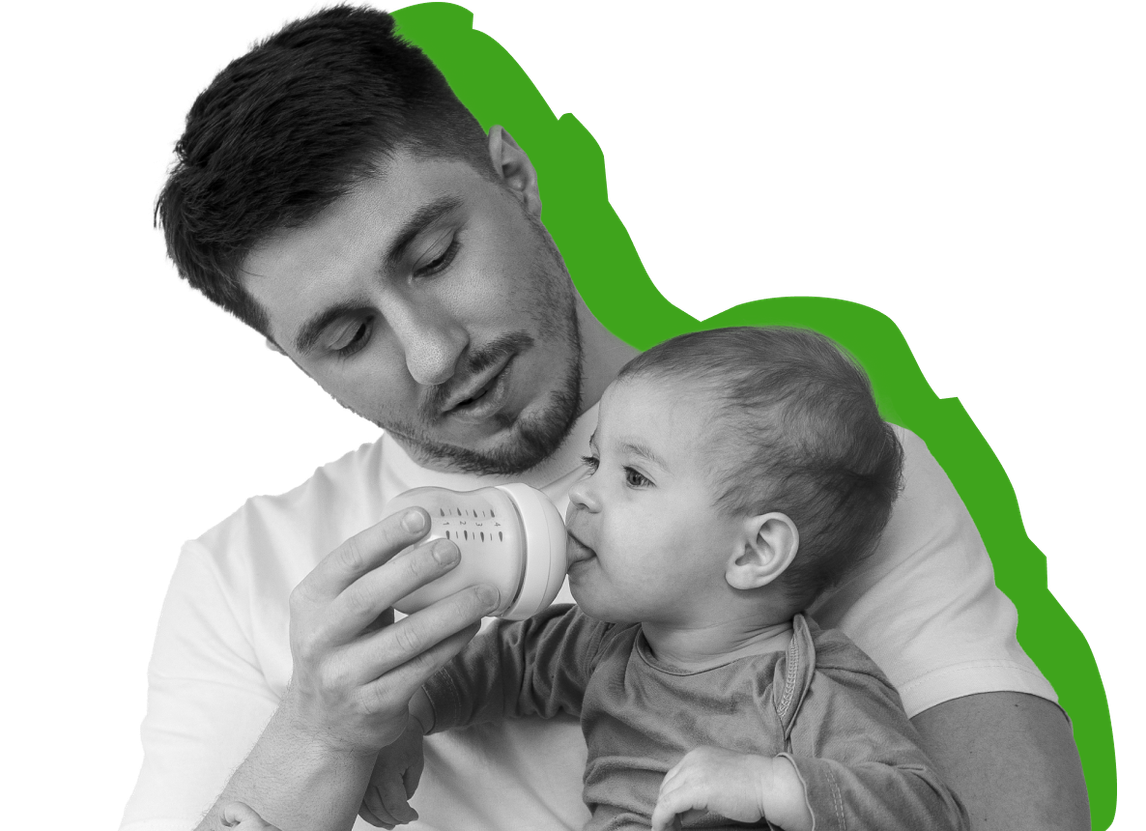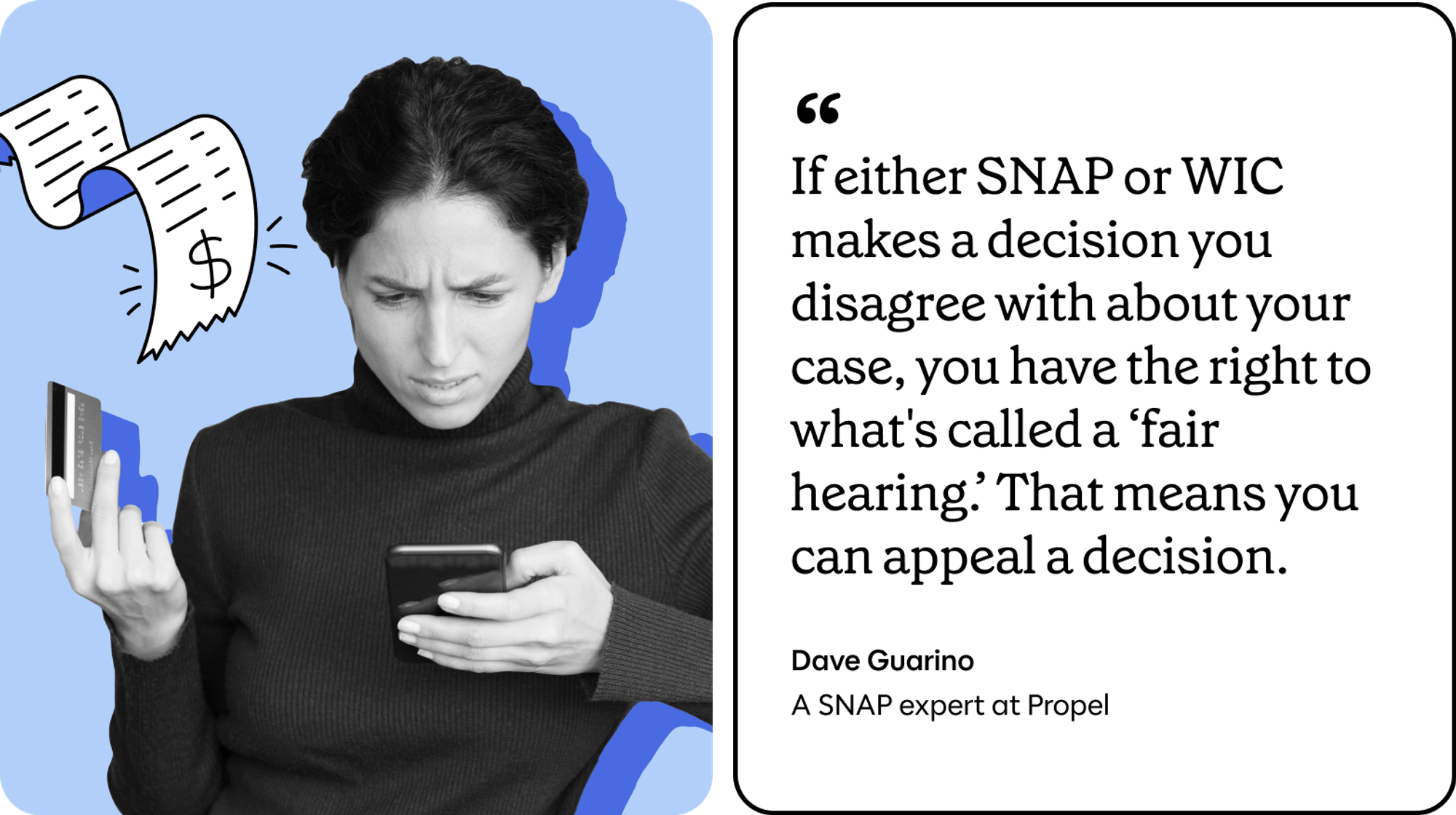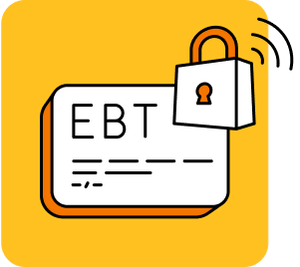


Additional expert review by
- SNAP vs. WIC: How are they different?
- SNAP eligibility requirements
- WIC eligibility requirements
- Recertification requirements
- Applying for benefits
- What to buy with your benefits and how
- How to shop with SNAP & WIC
- Key differences in SNAP vs. WIC
- Time limits
- Program flexibility & shopping
- Immigration requirements
- Frequently asked questions (FAQ)
- Takeaway
Table of contents
- SNAP vs. WIC: How are they different?
- SNAP eligibility requirements
- WIC eligibility requirements
- Recertification requirements
- Applying for benefits
- What to buy with your benefits and how
- How to shop with SNAP & WIC
- Key differences in SNAP vs. WIC
- Time limits
- Program flexibility & shopping
- Immigration requirements
- Frequently asked questions (FAQ)
- Takeaway
SNAP and WIC are two food assistance programs that help low-income families get the nutrition they need.
The Supplemental Nutrition Assistance Program (SNAP), also known as food stamps, and the Special Supplemental Nutrition Program for Women, Infants, and Children (WIC) are two major food assistance programs in the US. SNAP helps low-income families stretch their grocery budget each month. WIC provides specific healthy foods and nutrition support to pregnant people, new parents, children under five, and foster families with foster children under five.
Research shows these programs work. In a multi-year study published in the American Journal of Public Health in 2022, people who got SNAP and WIC as children were 4 times more likely to have enough food later in life compared to those who didn't use the programs.
“A single mom might get $75 a month,” says Scott Carter, President and Chief Strategy Officer at Conduit Government Relations and public nutrition assistance advocate. “That’s not a lot, but maybe that means her family won’t have [only] mayonnaise sandwiches that month.”
Qualified families can get both SNAP and WIC at the same time. Using both programs gives you more food options than using just one. Here's what you need to know about:
- Differences between SNAP and WIC benefits
- How to qualify for SNAP and WIC
- How to apply in your state
- What foods you can buy with SNAP and WIC
SNAP vs. WIC: How are they different?#snap-vs-wic-how-are-they-different
SNAP and WIC are both government-funded programs improving access to food for low-income families. WIC is specifically designed for pregnant, postpartum, and breastfeeding individuals, infants, and kids who need help eating healthy.
About 42 million people in the United States use SNAP benefits. People qualify for SNAP benefits by meeting certain income and resource requirements.
WIC offers additional food, nutrition education, and healthcare referrals to low-income families. According to the USDA, WIC served 39 percent of infants in the country in 2023.
SNAP is available in all 50 states, Washington, D.C., the U.S. Virgin Islands, and Guam. Puerto Rico's version is called the Nutrition Assistance Program (NAP). WIC is available in all 50 states and 33 Indian tribal organizations, Washington, D.C., and U.S. territories of American Samoa, the Northern Mariana Islands, the U.S. Virgin Islands, Guam, and Puerto Rico. Both programs are funded by the federal government and administered by the different state or territory agencies.
SNAP eligibility requirements#snap-eligibility-requirements
Each state has its own rules for SNAP and WIC. Your age, the number of people living in your household, your combined household income, and your work and immigration status all factor into your eligibility.
In general, your SNAP household includes people you buy and cook food with. If you have a roommate but don't share food, they can apply for SNAP on their own.
There are exceptions to this rule. Some people must always be on the same SNAP application:
- Married couples
- Someone under age 22 living with their parents
- Legal guardians and adults caring for minors under 18
Not sure who to include? List everyone in your home and your caseworker will help you figure it out.
Each state sets its own income limits for SNAP. These limits change every year depending on the federal poverty level. SNAP eligibility rules look at two types of income:
- Gross monthly income: the amount of money you make before taxes
- Net monthly income: the amount of money you have left after taxes and other deductions are taken out of your gross monthly income. It's also known as take-home pay.
To qualify for SNAP, your gross monthly income and net monthly income must be below certain limits. Only 13 states consider your savings or assets in determining eligibility. Learn more about the income limits in your state here.
If you are between ages 16 and 59 and don't have any disabilities, you will probably need to meet work requirements to receive SNAP benefits. Those requirements include:
- Registering for work
- Participating in SNAP Employment and Training, depending on what your state requires
- Accepting job offers
- Not voluntarily quitting a job or reducing your work below 30 hours a week without a good reason
If you can work and don't have kids, you'll need to work at least 20 hours each week to keep receiving SNAP benefits for more than 3 months over 3 years.
You don't need to meet work requirements if you:
- Already work 30+ hours a week
- Care for a child under the age of 6 or someone with a disability
- Are in school or a treatment program
- Are a veteran or a senior
- Are experiencing homelessness
- Are pregnant
- Are exempt for physical or mental health reasons
To qualify for SNAP, students and non-citizens have to meet certain criteria. Check with your state SNAP agency to see if you qualify.
WIC eligibility requirements#wic-eligibility-requirements
You can get WIC if you are:
- Pregnant or had a baby in the last 6 weeks
- Breastfeeding a baby under 1 year old
- A parent, foster parent, or caregiver of a child under 5 years old
Like SNAP, each state sets its own WIC income rules. The state's requirements must fall between 100 and 185 percent of the federal poverty line.
A doctor or nurse needs to confirm your eligibility for WIC. You could qualify if you:
- Have low iron (anemia)
- Need to gain weight
- Have health issues that affect how you eat (hypothyroidism or hyperthyroidism)
- Are experiencing housing instability
Recertification requirements#recertification-requirements

Your SNAP and WIC benefits last for a set period of time, or your "certification period." You'll need to renew them at the end of your certification period to keep receiving support.
How often renew depends on your state. It may be every 6 months or once a year. In most cases, you’ll need to provide updated information similar to what you put on your application, like recent pay stubs and updated household information.
WIC renewal may also require a health check. You can have your doctor send in your evaluation or get evaluated at a WIC clinic.
“If either SNAP or WIC makes a decision you disagree with about your case, you have the right to what's called a ‘fair hearing’ or appeal. That means you can appeal a decision, like getting denied, if you think it was wrong,” says Dave Guarino, a SNAP expert at Propel, an app that helps you manage benefits like SNAP and WIC.
He notes that with SNAP, asking for a review often fixes the problem: "Particularly with SNAP, the first step is for the agency to take a second look at the decision. Sometimes requesting a fair hearing fixes problems without actually needing to do the hearing." Local legal aid organizations can also help you ask for a fair hearing.
It is super important to pay attention to all deadlines, Carter says. If you don’t, you’ll have to start the application process over. And, he adds, if your situation changes, such as getting a raise at work, you need to let the SNAP office know.
Applying for benefits#applying-for-benefits
Each state or territory has its own process for applying for SNAP benefits. Most have an online application, but you may also be able to apply in person, over the phone, or by mail. You'll need to prove who you are, show you qualify with supporting documents, and do an interview.
The two most important steps in the SNAP application process are doing an interview and submitting requested documents. “Unfortunately, a lot of people eligible for SNAP get denied because they don’t get past one of these two hurdles,” Guarino says. Propel has guides for people having trouble getting a SNAP interview or gathering the required documents,
"If you’re having trouble, don’t give up!" Carter says. "Food banks that do SNAP assistance or local legal aid can help you."
Each state or territory also has its own WIC application process, including a health check. SNAP recipients won't have to verify their income again when applying for WIC.
WIC offices may have a waitlist if they don't have the funding or ability to help everyone who applies right away. Agencies will prioritize applicants with the most serious health conditions.
What to buy with your benefits and how#what-to-buy-with-your-benefits-and-how
It's important to know what your benefits can and cannot be used for.
Here's what you can buy with SNAP:
- Fruits and vegetables
- Meat, poultry, and fish
- Dairy products
- Breads and cereals
- Snack foods
- Non-alcoholic beverages
- Seeds and plants to grow food
Here's what you cannot buy with SNAP:
- Beer, wine, liquor, cigarettes, or tobacco
- Vitamins, medicines, and supplements (If you see a “Supplement Facts” label, it is not eligible to be purchased with SNAP)
- Live animals
- Hot, prepared foods (unless you participate in the Restaurant Meals Program)
- Non-food items, including pet foods, cleaning supplies, and cosmetics
SNAP benefits are loaded electronically onto an EBT card that works just like a debit card at participating stores. Check your EBT balance and stay on top of your spending history through the Propel app.
WIC recipients receive a personalized monthly collection of healthy foods called a "food package." There are seven different packages designed for specific categories of participants.
- Food Package I: Infants 0-5 months
- Food Package II: Infants 6-11 months
- Food Package III: Participants with special dietary needs
- Food Package IV: Children 1-4 years
- Food Package V: Pregnant and partially breastfeeding parents
- Food Package VI: Postpartum parents
- Food Package VII: Fully breastfeeding parents
Your WIC food package is carefully tailored to match your individual needs. The foods you receive depend on your participant category, age if you're a child, and whether you're breastfeeding. Your WIC nutritionist will work with you to accommodate any special dietary needs or restrictions, for example, if you need lactose-free milk or have food allergies. They can also consider cultural food preferences when possible. The key food categories in a WIC package are:
- Fruits and vegetables (fresh, frozen, or canned)
- Milk, cheese, and yogurt
- Whole grain foods (bread, tortillas, pasta, brown rice)
- Protein (eggs, beans, peanut butter)
- Cereal
- 100% fruit/vegetable juice
- Canned fish (for some participants)
- Special infant formula and baby foods
The amount of each food you receive varies based on your participant category and individual needs. Your local WIC office can tell you exactly which brands and foods are available in your area, since options can differ between states. For example, your state may allow chunky or smooth peanut butter in a 16 oz. or 18 oz. jar, but not reduced-fat or store-ground peanut butter. The WICShopper app's "Scan" function will help you find WIC-approved substitutes if what you need isn't eligible.
If you have any medical conditions requiring special foods, your WIC clinic can modify your food package with support from your healthcare provider. WIC clinics can tailor packages by adjusting amounts below the maximum, accommodating dietary restrictions, providing special formulas with medical documentation, making substitutions for cultural preferences, and offering alternative options like lactose-free milk. The goal is to provide healthy, nutritious foods that work for you and your family while meeting important nutritional requirements.
Similar to SNAP, WIC benefits come on an eWIC card. You can use the WIC app to check which foods are eligible before shopping. When you check out, WIC-approved items are automatically sorted, and you'll want to use your WIC card as your first payment method.
How to shop with SNAP & WIC#how-to-shop-with-snap-and-wic
SNAP and WIC benefits aren't meant to cover your household's entire grocery bill. These tips can help stretch your food budget to the end of the month.
Before shopping:
- Check your SNAP balance in the Propel app
- Review available WIC benefits
- Plan meals using what you have first
- Check store sales and coupons
- Make a list focused on WIC/SNAP eligible items
- Research recipes using eligible ingredients
At the store:
- Stick to your list at the store
- Check expiration dates
- Consider buying non-perishables in bulk
- Start with WIC items first
At checkout, always use your WIC card first, followed by SNAP benefits and any other payment method. Be sure to review your receipt mid-transaction to confirm that WIC items are being deducted from your WIC balance, not SNAP.
Take advantage of additional resources in each program to stretch your benefits further. Visit farmers' markets that accept WIC and EBT, combine your purchases with items from food banks, and remember that SNAP can cover items WIC doesn't include, such as meat, canned soups, snack foods, and frozen meals.
Key differences in SNAP vs. WIC#key-differences-in-snap-vs-wic
SNAP and WIC are nutrition assistance programs with distinct features and requirements, though both help low-income families access healthy food.
Time limits#time-limits
SNAP benefits have different time limits based on your situation. Adults 18-54 without children can receive benefits for 3 months every 3 years, though this extends if you work more than 20 hours weekly or participate in job training. Depending on your state, you might have to renew your benefits quarterly, every 6 months, or more frequently.
WIC provides benefits for specific groups: pregnant individuals up to 6 weeks after birth, breastfeeding individuals up to a year after birth, non-breastfeeding parents up to 6 months after birth, infants in their first year, and children until age 5. Participants typically recertify every 6 to 12 months to confirm eligibility and review nutritional needs.
Program flexibility & shopping #program-flexibility-and-shopping
SNAP benefits are more flexible than WIC benefits. SNAP benefits roll over month-to-month and can be used for a wide range of foods. WIC food packages contain specific foods and expire at the end of your certification period.
Immigration requirements#immigration-requirements
SNAP requires participants to be US citizens or meet certain non-citizen criteria, like being a legal permanent resident for 5 or more years, having refugee or asylee status, or being victim of trafficking. Children under 18 with eligible non-citizen status can also receive SNAP.
Immigration status does not affect WIC eligibility.
“For WIC, your immigration status does not matter. This is different from SNAP,” Guarino says. “If you’re pregnant or have a baby but have a more complicated immigration situation, know that WIC is still there to help you.”
Frequently asked questions (FAQ)#frequently-asked-questions-faq
Q: What are the disadvantages of using WIC?
A: Shopping could be more time-consuming because you are required to purchase specific brands and sizes of products. Use the WICShopper app to plan ahead and save time at the grocery store.
Q: Who benefits most from the SNAP program?
A: Families with children, the elderly, and people with disabilities tend to benefit most from SNAP.
Q: Who benefits most from the WIC program?
A: Individuals who are pregnant or breastfeeding and children under the age of 5 who are at nutritional risk from medical conditions or inadequate diets benefit the most from WIC.
Q: Can you get WIC and food stamps at the same time in Florida?
A: Yes, if you are eligible for both. It's easier to get approved for WIC when you already participate in SNAP.
Q: What does SNAP stand for?
A: SNAP stands for the Supplemental Nutrition Assistance Program.
Q: What happens to my SNAP benefits if I move?
A: You can keep using your current benefits if staying in the same state. For out-of-state moves, you'll need to close your case and reapply since eligibility requirements vary between states. Your EBT card balance from your old case is still available to use anywhere in the country.
Q: What happens to my WIC benefits if I move?
A: For WIC benefits, always notify your clinic about moving, whether changing locations locally or going to another state. Before moving, get a transfer card from your current WIC office to prove your participation. Then call the new WIC office for an appointment and bring the transfer card. Your benefits will continue until your certification period ends.
Q: What is an authorized vendor?
A: A grocer or store that has been approved to accept SNAP or WIC benefits.
Q: What is the certification period?
A: The amount of time you are eligible to receive SNAP or WIC benefits.
Takeaway#takeaway
You can receive SNAP and WIC benefits at the same time. If you're pregnant or have recently given birth, applying for both programs can maximize your food assistance. Telling your SNAP office when your baby arrives could increase your benefits. If you already get SNAP, Medicaid, or Temporary Aid to Needy Families (TANF) benefits, qualifying for WIC is simpler since you won't need to prove your income again.
Apply through your state program and check out the Propel blog for more tips on making the most of your benefits.








